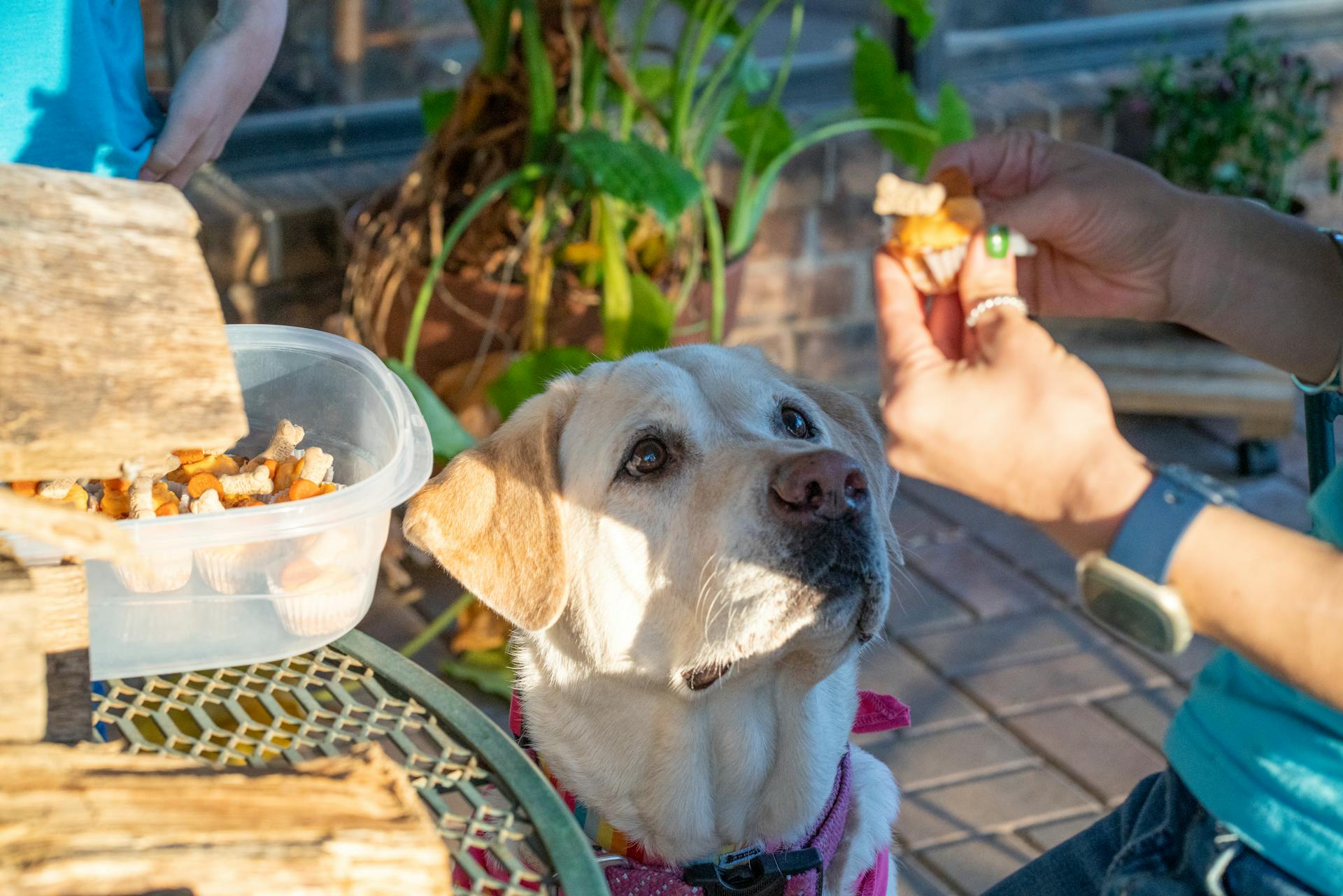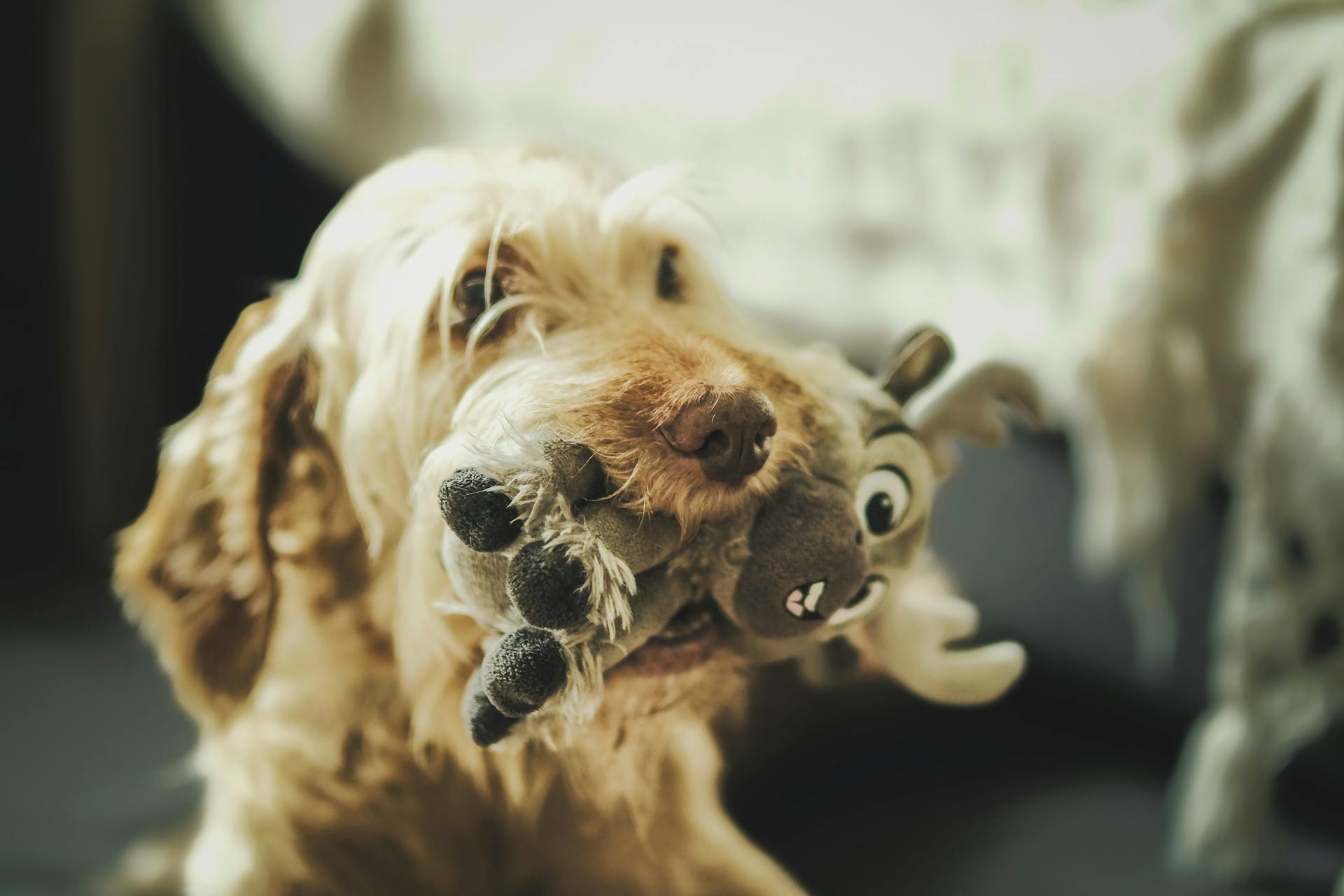
Making homemade food puzzles for your dog is a great way to stimulate their mind and keep them engaged while eating. This can help reduce boredom and stress.
By using different shapes, sizes, and textures, you can create a variety of puzzles that challenge your dog to figure out how to get their food out.
A simple example is a cardboard box with holes cut out of different sizes, which can be filled with your dog's favorite treats or kibble.
Benefits and Advantages
Making homemade food puzzles for dogs can have a significant impact on their mental and physical well-being. By providing a fun and stimulating activity, you can challenge your dog's brain and keep them mentally sharp.
Mental stimulation is one of the most common goals pet parents have when incorporating DIY dog puzzles into their pup's routine. Solving puzzles requires concentration, problem-solving, and memory skills, which can help keep your pup's brain in tip-top shape.
Physical exercise is another benefit of homemade food puzzles. Many DIY dog puzzles require physical activity to solve them, whether it's pushing, pulling, or pawing at a puzzle, your dog will get a workout while having fun.
Stress relief is also a major advantage of homemade food puzzles. Dogs can experience stress and anxiety, and we don't always love how they choose to relieve their own stress. DIY dog puzzles can help alleviate stress by providing a constructive outlet for that stress.
Here are some of the most common goals pet parents might have for incorporating DIY dog puzzles into their pup's routine:
- Mental stimulation: DIY dog puzzles challenge your dog's brain and keep them mentally sharp.
- Physical exercise: Many DIY dog puzzles require physical activity to solve them.
- Stress relief: DIY dog puzzles can help alleviate stress by providing a constructive outlet for that stress.
- Bonding time: Solving puzzles together can be a great bonding experience for you and your furry friend.
- Species-typical behaviors: DIY dog puzzles allow your dog to be a dog in a healthy, safe, and appropriate way.
Types and Ideas
Making homemade food puzzles for dogs can be a fun and rewarding experience. You can use a variety of materials, such as cardboard boxes, plastic containers, and PVC pipes.
Some popular types of homemade food puzzles include interactive treat-dispensing toys and problem-solving games.
Using a muffin tin and a variety of healthy fillings like peanut butter and banana slices can create a tasty and challenging puzzle.
Other ideas include using a Kong toy filled with a mixture of kibble and canned food, or creating a maze using a cardboard box and some creative cutting.
DIY and Crafting
You can make your own dog food puzzles at home using items like cardboard boxes, packing paper, and even grass in your yard. Craft your own snuffle mat or use a plastic sink mat as a base, which can be found at most hardware stores.
Fleece fabric is a great material to use for your DIY snuffle mat, and you can cut it into 1-inch wide by 6-inch long strips using scissors or a rotary cutter. Tie each strip through the grid/drain holes on the sink mat until the fabric is thick enough to prevent treats from falling through.
A tennis ball treat puzzle is another fun and interactive option, made by cutting a tennis ball in half and stuffing it with your dog's favorite treats or dry kibble. The felt on the tennis ball keeps the rubber from tearing, making it a durable and quiet puzzle for your dog.
Take a look at this: Puzzle Food Bowl Dogs
Here are some DIY boredom busters for your dog, including a PVC pipe puzzle that requires a power drill and can be assembled with ease, but is a challenging puzzle for your dog to figure out.
A DIY snuffle mat is a colorful activity mat for your dog to sniff out treats, and can be made by tying fleece strips through the grid/drain holes on a plastic sink mat. This project is a bit time-consuming, but can be a fun and rewarding activity to do with friends while your dog plays nearby.
Games and Activities
If you're looking to challenge your dog's mind and encourage their natural foraging skills, consider setting up a muffin tin game. This DIY enrichment toy is easy to set up and can be a great way to stimulate your furry friend's sniffing abilities.
To play, you'll need a muffin tin, tennis balls, and treats. Simply hide the treats underneath the tennis balls and let your pup sniff them out. This game is similar to a snuffle mat and can be a fun and engaging way to provide mental stimulation for your dog.
Here's a simple step-by-step guide to get you started:
- Find a muffin tin
- Find tennis balls
- Hide treats underneath
This game is a great way to provide your dog with a fun and challenging activity that will keep them engaged and stimulated. Give it a try and see how your furry friend enjoys it!
Safety and Introduction
Introducing your dog to homemade food puzzles should be done gradually and with patience. Start with easy puzzles that are easier for your dog to solve, and use high-value treats to make them more enticing.
If your dog is struggling to solve a puzzle, offer gentle guidance by showing them how to solve it. Gradually reduce your assistance as they understand the concept. Be patient with your dog as they learn and build their confidence.
To ensure your dog's safety, use your discretion when introducing them to new puzzles. If you know your dog will try to consume fabric or eat plastic, skip those puzzles. If your dog has a sensitive tummy, modify the puzzles to use safe ingredients like iceberg lettuce.
Safety Tips

As you consider creating DIY dog puzzles, remember that safety should be your top priority. If your dog has a history of eating fabric, it's best to skip towel treat puzzles altogether.
Know your dog's limits and modify DIY dog puzzle ideas accordingly. If your dog has a sensitive tummy, iceberg lettuce is a safer alternative to cabbage.
How to Introduce Your Dog to Homemade Food Puzzles
Introducing your dog to homemade food puzzles should be done gradually and with patience. Start with simple puzzles that are easier for your dog to solve, as this will build their confidence and motivate them to continue solving more challenging puzzles.
Use high-value treats to make the puzzles more enticing. Your dog's favorite treats will motivate them to engage with the puzzles and keep them interested.
If your dog is struggling to solve a puzzle, offer gentle guidance by showing them how to solve it. Once they understand the concept, gradually reduce your assistance.
To make a homemade food puzzle more challenging, you can start soaking the food in water or low-sodium broth before stuffing the toy. This will make it harder for your dog to access the food, but still fun and rewarding.
Here are some tips to keep in mind when introducing your dog to homemade food puzzles:
Treat Dispensers and Feeders
Making homemade treat dispensers and feeders is a fun and easy way to keep your dog engaged and stimulated. You can start with a muffin tin and hide treats underneath tennis balls for a game of Hide & Seek Muffin Tin Treat Game.
Tennis balls are a great material for making treat dispensers, as seen in the Tennis Ball Treat Dispenser example. Simply cut open a hollow ball, tennis ball, or used plastic water bottle and place treats inside.
Interactive feeders like KONGs, Toppl, or other stuffable feeders are also a great option. To use one, smear a small bit of peanut butter or wet food on the outside and inside of the opening to help your dog learn where to lick.
See what others are reading: Why Do Dogs Hide Food
The key to using these feeders is to start with a small amount of food and gradually increase the difficulty level as your dog becomes more confident. For example, you can start by filling the feeder with just a spoonful of dry food and adding a smear of wet food or peanut butter on the lip.
Here are some benefits of using interactive feeders and puzzles:
- Provides enrichment for your dog's sense of taste, smell, and texture
- Slows down dogs who eat too fast, reducing the risk of choking or bloat
- Helps dogs who are picky eaters by making mealtime more engaging
- Soothes puppy teething by providing a calming activity
- Helps with crate training by keeping your dog occupied and reinforcing good behavior
- Calms hyper or anxious dogs by providing a repetitive and calming activity
Frequently Asked Questions
What do you put in a dog food puzzle?
You can fill a dog food puzzle with a variety of options, including their regular dog food, wet food, treats, and homemade mixes. Experimenting with different fillings can provide mental stimulation and add variety to your dog's diet.
Sources
- https://petharmonytraining.com/5-diy-dog-puzzle-ideas-for-cheap-canine-enrichment/
- https://post.bark.co/fun/3-dog-toys-you-can-make-from-things-around-the-house/
- https://www.rover-time.com/six-diy-food-puzzles-stuff-around-house/
- https://www.preventivevet.com/dogs/the-best-interactive-toys-and-food-puzzles-for-your-dog
- https://www.impactdogcrates.com/blogs/puppy-news/diy-dog-puzzles
Featured Images: pexels.com


